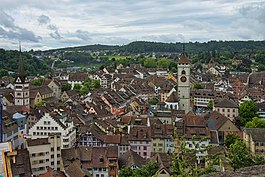Schaffhausen
| Schaffhausen | ||
|---|---|---|

Schaffhausen in 2012
|
||
|
||
| Coordinates: 47°42′N 8°38′E / 47.700°N 8.633°ECoordinates: 47°42′N 8°38′E / 47.700°N 8.633°E | ||
| Country | Switzerland | |
| Canton | Schaffhausen | |
| District | (None in canton of Schaffhausen) | |
| Government | ||
| • Executive |
Stadtrat with 5 members |
|
| • Mayor |
Stadtpräsident (list) Peter Neukomm SPS/PSS |
|
| • Parliament |
Grosser Stadtrat with 36 members |
|
| Area | ||
| • Total | 41.86 km2 (16.16 sq mi) | |
| Elevation | 403 m (1,322 ft) | |
| Population (Dec 2015) | ||
| • Total | 35,948 | |
| • Density | 860/km2 (2,200/sq mi) | |
| Postal code | 8200 | |
| SFOS number | 2939 | |
| Surrounded by | Beringen, Büsingen am Hochrhein (DE-BW), Büttenhardt, Dörflingen, Feuerthalen (ZH), Flurlingen (ZH), Hemmental, Merishausen, Neuhausen am Rheinfall, Stetten, Thayngen | |
| Twin towns | Sindelfingen (Germany), Singen am Hohentwiel (Germany), Dobrich (Bulgaria) | |
| Website |
www Profile (German), SFSO statistics |
|
| Imperial City of Schaffhausen | ||||||||||
| Reichsstadt Schaffhausen | ||||||||||
| Free Imperial City of the Holy Roman Empire | ||||||||||
|
||||||||||
| Capital | Schaffhausen | |||||||||
| Government | Republic | |||||||||
| Historical era | Middle Ages | |||||||||
| • | Gained Reichsfreiheit | betw 1190 and 1218 | ||||||||
| • | Pledged to Habsburgs | 1330 | ||||||||
| • | Bought independence | 1415 | ||||||||
| • |
Associate member of Swiss Confederacy |
1454 |
||||||||
| • | Joined Switzerland | 1501 | ||||||||
| • | Swiss independence recognised |
1648 |
||||||||
|
||||||||||
| Imperial Abbey of All Saints in Schaffhausen | ||||||||||
| Reichskloster Allerheiligen, Schaffhausen | ||||||||||
| Imperial Abbey of the Holy Roman Empire | ||||||||||
|
||||||||||
| Capital | Schaffhausen | |||||||||
| Government | Principality | |||||||||
| Historical era | Middle Ages | |||||||||
| • | Consecrated (Leo IX) | 22 November 1049 | ||||||||
| • |
Papal grant of Nellenburg lands |
1080 | ||||||||
| • | Gained Hiltensweiler lands |
1122–1389 |
||||||||
| • | City became Swiss Associate |
1454 |
||||||||
| • | City joined Switz. | 1501 | ||||||||
| • | Converted to monastery and cathedral church |
1524 |
||||||||
| • | Disestablished in Reformation |
1529 | ||||||||
|
||||||||||
Schaffhausen (German: [ˈʃafˌhauzən]; Alemannic German: Schafuuse; French: Schaffhouse; Italian: Sciaffusa; Romansh: Schaffusa) is a town in northern Switzerland and the capital of the canton of the same name; it has an estimated population of 34,587 as of December 2008[update].
The official language of Schaffhausen is the Swiss variety of Standard German, but the main spoken language is the local variety of Swiss German.
The old portion of the city has many fine Renaissance era buildings decorated with exterior frescos and sculpture, as well as the impressive old canton fortress, the Munot. A train runs out of town to the nearby Rhine Falls in Neuhausen am Rheinfall, Europe's largest waterfall, a tourist attraction.
The town is first mentioned in 1045 as Villa Scafhusun. There are at least two theories on the origin of this name. One is related to a mention of a "ford" across the Rhine River that first occurs in 1050. This "ford" may actually refer to a scapha or skiff which was used to disembark goods coming from Constance to move them around the Rhine Falls. The name Scafhusun then arose from the scapha used at that point. Another theory is that Scafhusun comes from Schaf (a sheep), as a ram (now a sheep) formed the ancient arms of the town, derived from those of its founders, the counts of Nellenburg.
...
Wikipedia



